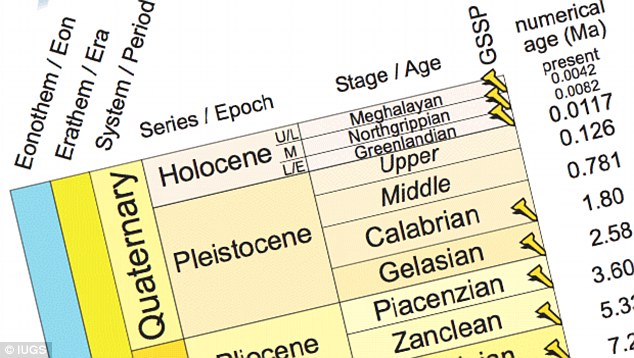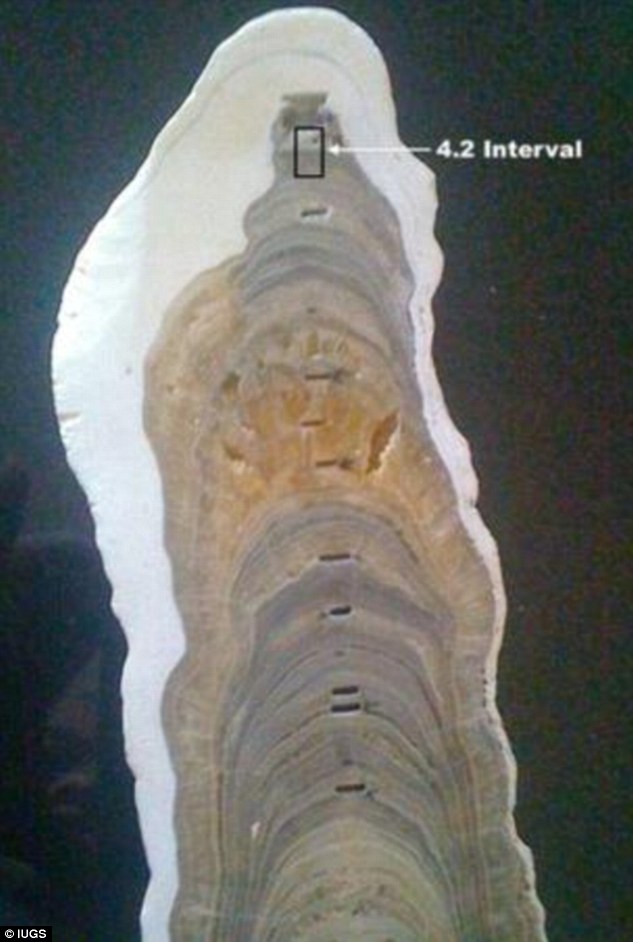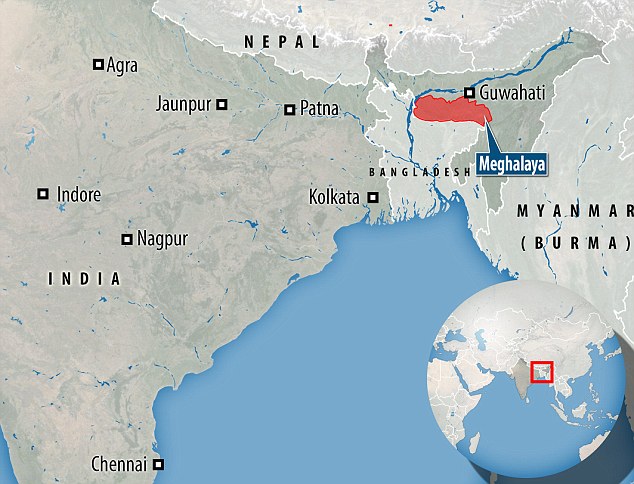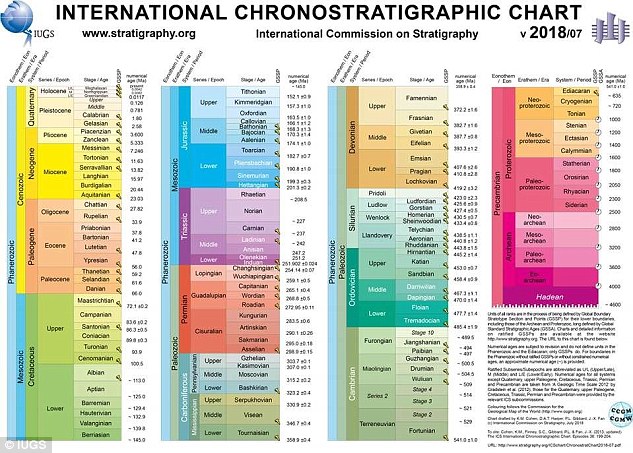This post was prompted by a question from a member of SIS – what is the progress and current thinking on the Meghalayan? Well, they are still discussing it I suppose, with no agreement as yet. I suspect many geologists are quite happy with the designation of the Holocene without carving it up into smaller segments. The idea of the Meghalayan Age first raised its public face at the IUGS conference of July 2018 (the International Union of Geological Sciences). It caused a bit of a stir at the time but this has since subsided. Just as geologists are divided on current levels of global warming so too are they divided on adopting any of the offshoots of climate change – which the Meghalayan and the Anthropocene most surely are. A good discussion on the subject is at https://theconversation.com/anthropocene-vs-meghalayan-why-geologists-ar… … but you need to skim over the hand waving acceptance of climate change while reading the piece, especially the final paragraph. In July of 2018 we were told Earth was now in a new slice of time, a sliver of time to be exact, dubbed the Meghalayan Age. The announcement seems to have confused and angered geoscientists from all over the world. It is said to have began 4250 years ago. This contrasts with the Anthropocene – which concerns only the modern era. Geologists don't do periods as short as that. Normally.
The geological time scale is a massive achievement the writer enthuses, dividing all of earth history into meaningful units of time representing key changes in the earth system and environment. It is typically based on some life forms dying out and others evolving, or arriving in the fossil record. Fossils therefore dominate the geological column. The announcement effectively splits the Holocene into three ages. First, we have the Greenlandian, dating from 9700 to 6326BC, followed by the Northgrippian which dates down to 2250BC when the Meghalayan kicks in (continuing to the present and ignoring the more dubious Anthropocene). We don't know enough about modern climate change to adopt that designation according to some geologists. It may revert to cooler temperatures and geologists would look like fools if that happened. Basically, modern warming is too short to justify a geological category of its own. This division of the Holocene into 3 segments is the geological retort to climate change activists exerting pressure on them – it might be thought. Geology is mainly focussed on field evidence – interpreting the rocks. They may get it wrong on occasion, is the general opinion, as geology is full of changes in the status of rocks as opinions differ over time. It is the fossil record that dictates the periods – and one may wonder where the fossil record of the Meghalayan comes in (although we do have geological deposits of the period). In contrast, the Anthropocene is lacking field evidence. It is also utterly devoid of fossils and is based on computer modelling – and projection. It is in effect quite different from geological practise.
The division of the Holocene into segments has in any case already been done, in years past. We have the Younger Dryas event which is followed by the Pre-Boreal, Boreal, Atlantic, sub-Boreal and sub-Atlantic. This was Euro centric in that the Atlantic phase denotes a period of wetness (in NW Europe and elsewhere) but coinciding with dry weather in other parts of the world. Hence, the designations are out of date and require revising as far as nomenclature is concerned. The new division is threefold rather than five fold and although the Boreal/Atlantic division is maintained (from Greenlandian to Northgrippian) the other points of division differ. Having said that the new divisions recognise the importance of the 6200BC event – when sea levels around the world display evidence of big changes, especially in SE Asia and NW Europe. The Northgrippian period comes to an end contemporary with the First Intermediate Period in Egypt (and the collapse of EB civilisations in western Asia). They actually use evidence of drought in Egypt, the Levant and Mesopotamia, as well as in India and China, to back up a switch into the Meghalayan. At SIS we have had a string of articles by Moe Mandelkehr on the very same subject – which he defined as the 2300BC event (combining Baillie's 2345 and 2200BC environmental downturn events). After the latter date drought became a major problem in different parts of the world. In other words, Mandelehr was ahead of the game.
The Meghalayan Age defines the Late Holocene but makes no mention, it would seem, of similar droughts (including at the end of the LB age, in 1200BC). In fact, Eric Cline criticises the new division as he claims the end of LB age was as disastrous as the end of the EB age, but geologists are not archaeologists and the Meghalayan is grounded on a particular study. The strange thing is that drought is recorded right across the Mediterranean world and Mesopotamia, through Iran to India and China (indicating a connection with the monsoon track) whereas in NW Europe it was exactly the opposite – extremely wet. It was so wet as a result of persistent rainfall that it coincides with the formation of peat deposits. These support Cline's criticism as peat formation was rampant around 3000BC as well as 2200BC, and again, around 1200BC. The article then goes on to say we don't know what the situation was in Africa, the Americas, and Australasia at the start of the Meghalayan. However, Moe Mandelkehr had lots to say of these regions in his articles, providing a truly global focus for his 2300BC event. Unfortunatelyh, not many people read the SIS Review and avoid the idea of catastrophism like the plague.
The Meghalayan was greeted by reports right across the media – for example see www.dailymail.co.uk/sciencetech/article-5967095/ …
 … where the actual field evidence for the drought is discussed. The Greenlandian and the Northgrippian have at their heart ice core data from Greenland (defining changes in global temperatures) but the Meghalayan is based on field evidence such as speleotherm data from a cave in NE India (as well as subsidiary evidence from sea bed sediment cores, stalagmites, and texts referring to drought and famine in historical sources). The date also refers to the collapse of EB culture in the ancient world, as previously noted. There was also a drastic fall in human population numbers. Below is the speleotherm (stalagmite) with the record of droughts that the geologists are using as their bed rock of the three fold division …
… where the actual field evidence for the drought is discussed. The Greenlandian and the Northgrippian have at their heart ice core data from Greenland (defining changes in global temperatures) but the Meghalayan is based on field evidence such as speleotherm data from a cave in NE India (as well as subsidiary evidence from sea bed sediment cores, stalagmites, and texts referring to drought and famine in historical sources). The date also refers to the collapse of EB culture in the ancient world, as previously noted. There was also a drastic fall in human population numbers. Below is the speleotherm (stalagmite) with the record of droughts that the geologists are using as their bed rock of the three fold division …
 See also www.smithsonianmag.com/smart-news/welcome-meghalayan-age-latest-stage-ea… … where we learn that the Anthropocene is supported by a geography professor at University College in London. He told the BBC news that after the original paper (on the Anthropocene) going through various committees, the geologists suddenly announced the Meghalayan. True or not. How the little cogs set the big cogs in motion. Mice and men and all that.
See also www.smithsonianmag.com/smart-news/welcome-meghalayan-age-latest-stage-ea… … where we learn that the Anthropocene is supported by a geography professor at University College in London. He told the BBC news that after the original paper (on the Anthropocene) going through various committees, the geologists suddenly announced the Meghalayan. True or not. How the little cogs set the big cogs in motion. Mice and men and all that.
See also www.nationalgeographic.com/science/2018/09/news-meghalayan-holocene-mega… … which asks how the megadrought affected humanity. As in all these articles what might have caused a megadrought at this time is not part of the narrative – as the field evidence shows it did occur (and presumably that is enough for the curiosity of the media). The drought is the defining point – but megadroughts at 3200BC and 1200BC are left largely unmentioned, although equally significant for humanity at large. It is no accident the megadrought at 2200BC is supported by textual reference in a variety of sources. It is virtually unchallengeable.
See also www.bbc.co.uk/news/science-environment-44868527/ … which seems to bit upset the Anthropocene idea has been punctured – and of course the Wiki entry on the subject at https://en.wikipedia.org/wiki/Meghalayan … where we learn the name comes from a cave system in Meghalaya in NE India …
 … … … which contained the stalagmites used in the research. In one of the largest and deepest caves in India they found evidence and chemical signals of the switch in precipitation levels from age to age (mapping out the Holocene period). It quotes www.hindustantimes.com/science/story-bvbKrd33IXgMD1o6BaSjmM.html … In the Wiki graph the Northgrippian is dated from 8200 years ago = 6200BC rather than 6350BC in The Conversation, and the Meghalayan from 2200BC rather than 2250BC (thereby complying with Baillie's tree ring data).
… … … which contained the stalagmites used in the research. In one of the largest and deepest caves in India they found evidence and chemical signals of the switch in precipitation levels from age to age (mapping out the Holocene period). It quotes www.hindustantimes.com/science/story-bvbKrd33IXgMD1o6BaSjmM.html … In the Wiki graph the Northgrippian is dated from 8200 years ago = 6200BC rather than 6350BC in The Conversation, and the Meghalayan from 2200BC rather than 2250BC (thereby complying with Baillie's tree ring data).
The beauty of all this from a catastrophist angle is that we already know that the geological column is defined by extinction events (natural disasters of various kinds) and now we have the Holocene subdivided into recognised catastrophic events (causes unknown but involving drought and famine) – particularly at 6200 and 2200BC. As Eric Cline has already pointed out the end of LB age around 1200BC can be defined as similar in nature. Cline concedes that a variety of factors were in play to account for the LB site destructions. Invasion and warfare was a sort of background feature – and no doubt some cities were taken by storm. Most of the sites destroyed were either due to earthquake or other unknown factors that can only be guessed at. He thinks an explanation will emerge in due course. We may note the same thing applies to the end of the EB age at the beginning of the Meghalayan. Many sites across the Levant, Anatolia and the Aegean were destroyed – some towns that then existed are still ruin mounds and have never been rebuilt. Obviously, it involved a lot more than a megadrought (which came in the wake of the site destructions). Geologists have, for the moment, stranded this one event in a time capsule but other catastrophes at 4250 and 3200BC need to be integrated into the model. That said we have to accept that we cannot have too many divisions in the geology of the Holocene. Suffice for small mercies. One of the events, at least, has now been provided with special status. Two if you include the 6200BC event.

